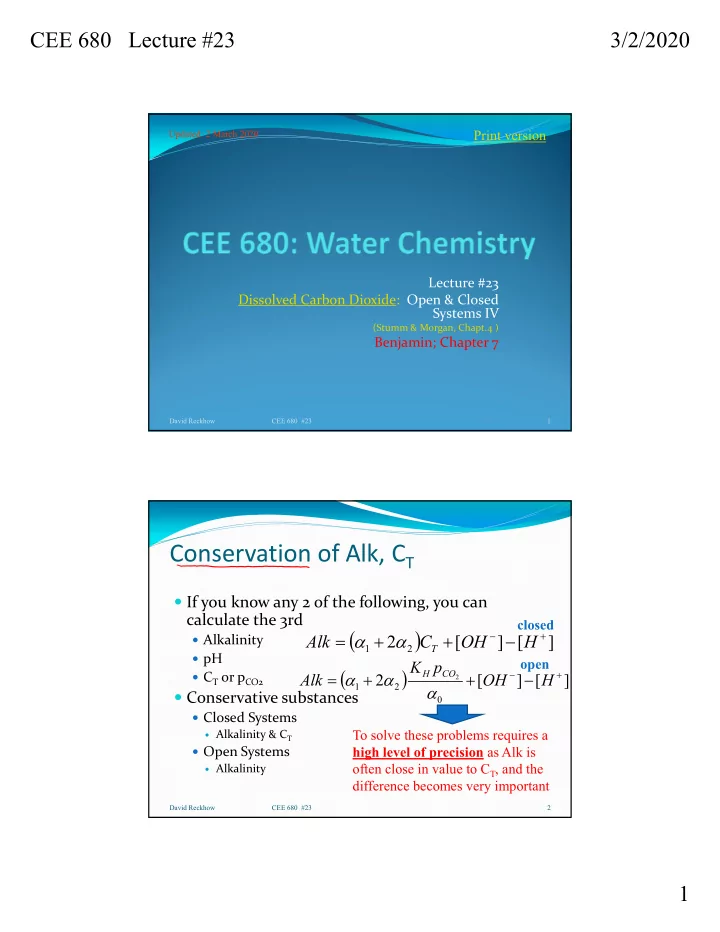

CEE 680 Lecture #23 3/2/2020 Print version Updated: 2 March 2020 Lecture #23 Dissolved Carbon Dioxide: Open & Closed Systems IV (Stumm & Morgan, Chapt.4 ) Benjamin; Chapter 7 David Reckhow CEE 680 #23 1 Conservation of Alk, C T If you know any 2 of the following, you can calculate the 3rd closed Alk 2 C [ OH ] [ H ] Alkalinity 1 2 T pH open K p H CO C T or p CO2 Alk 2 [ OH ] [ H ] 2 1 2 Conservative substances 0 Closed Systems To solve these problems requires a Alkalinity & C T high level of precision as Alk is Open Systems often close in value to C T , and the Alkalinity difference becomes very important David Reckhow CEE 680 #23 2 1
CEE 680 Lecture #23 3/2/2020 Alkalinity, C T and pH Three types of problems are covered Adding treatment chemicals to water e.g., Soda Ash, Caustic, chlorine Blending of waters e.g., a surface water with a groundwater Impacts of “internal” processes The photosynthesis problem In each we ask about the final pH, Alkalinity and sometimes the C T or carbonate species David Reckhow CEE 680 #23 3 Addition of Treatment Chemicals Water pH C T (mM) Alk Acy (meq/L) (meq/L) “A” 6.5 1.7 1 2.4 A+ 0.7mM 8.3 1.7 1.7 1.7 NaOH A + 0.7mM 8.3 2.4 2.4 2.4 Na 2 CO 3 Assumes a closed system; now determine the composition of each in an open system; Also recall: Alk tot + Acy tot = 2C T David Reckhow CEE 680 #23 4 2
CEE 680 Lecture #23 3/2/2020 Chlorine problem Starting water B pH=8, Alkalinity = 82.5 mg ‐ CaCO 3 /L, NH 3 ‐ N=3.5 mg/L Alk=1.65 meq/L, NH 3 ‐ N=0.25 mM Use breakpoint chlorination to remove ammonia ‐ N C 2NH 3 + 3Cl 2 = N 2 (g) + 6H + + 6 Cl ‐ How much NaHCO 3 and NaOH must be added to reach pH 9.0 and 2.0 mM C T ? E D Snoeyink & Jenkins, example 4-39, pg.188 David Reckhow CEE 680 #23 5 Deffeyes Diagram Alk 2 C [ OH ] [ H ] 1 2 T For 15 o C, closed system (has C T , not p CO2 ) Snoeyink & Jenkins, pg187 Stumm & Morgan, pg 177 Answer to previous problem 0.35 mM NaHCO 3 0.75 mM NaOH D E David Reckhow CEE 680 #23 6 3
CEE 680 Lecture #23 3/2/2020 Ken Deffeyes Princeton Nomograph Redrawn Deffeyes diagram From Benjamin, 2002 Pg. 275 David Reckhow CEE 680 #23 7 Blending of Waters Water A C T = 8 mM Alk = 300 mg/L pH = ? Water B C T = 4 mM Alk = 100 mg/L pH ? 50/50 Blend David Reckhow CEE 680 #23 8 4
CEE 680 Lecture #23 3/2/2020 David Reckhow CEE 680 #23 9 Nomograph Redrawn Deffeyes diagram From Benjamin, 2002 Pg.275 David Reckhow CEE 680 #23 10 5
CEE 680 Lecture #23 3/2/2020 David Reckhow CEE 680 #23 11 In ‐ Class Practice For a closed system, what is the pH of: 10 ‐ 3 M solution of H 2 CO 3 10 ‐ 3 M solution of NaHCO 3 10 ‐ 3 M solution of Na 2 CO 3 For an open system, what is the pH of: 10 ‐ 3 M solution of H 2 CO 3 10 ‐ 3 M solution of NaHCO 3 10 ‐ 3 M solution of Na 2 CO 3 David Reckhow CEE 680 #24 12 6
CEE 680 Lecture #23 3/2/2020 More practice What is the pH of a blend of the following: 1 MGD of pH 6.5 water with a Alkalinity of 5o mg/L 0.5 MGD of pH 8.5 water with an Alkalinity of 500 mg/L K p H CO Alk 2 [ OH ] [ H ] 2 1 2 0 Alk 2 C [ OH ] [ H ] 1 2 T David Reckhow CEE 680 #24 13 David Reckhow CEE 680 #24 14 7
CEE 680 Lecture #23 3/2/2020 w David Reckhow CEE 680 #23 15 w David Reckhow CEE 680 #23 16 8
CEE 680 Lecture #23 3/2/2020 0 -1 H + OH - -2 Open System Diagram -2 CO 3 -3 - HCO 3 -4 * H 2 CO 3 -5 -6 Log C -7 -8 -9 -10 -11 -12 -13 -14 0 1 2 3 4 5 6 7 8 9 10 11 12 13 14 David Reckhow CEE 680 #24 pH 17 To next lecture David Reckhow CEE 680 #23 18 9
Recommend
More recommend